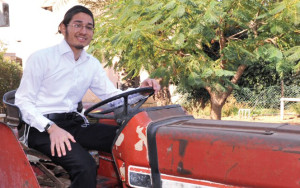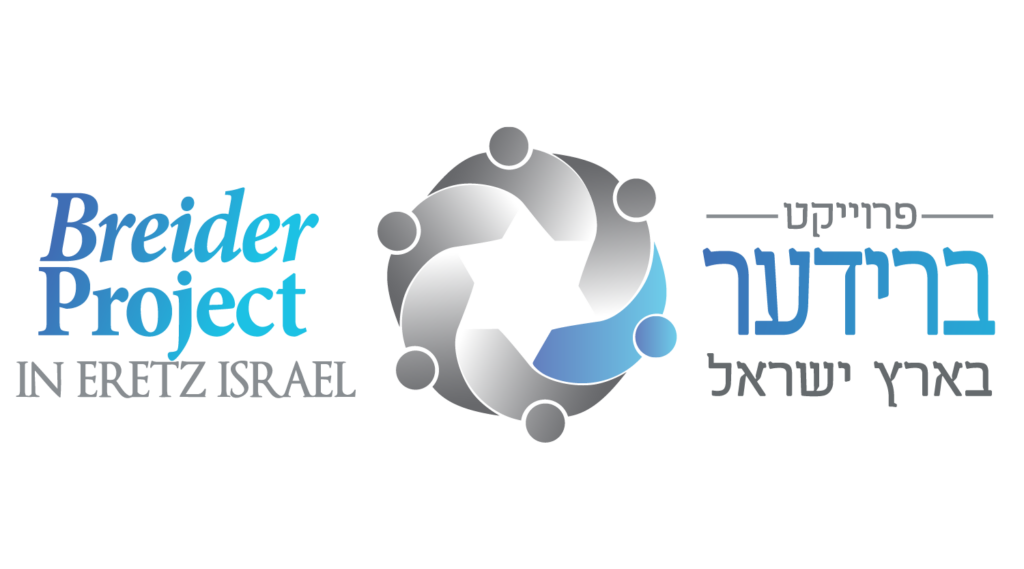A Visit to Moshav Berechyah
 It is a long trip to Moshav Berechyah, four kilometers east of Ashkelon. On a Sunday morning following at “out Shabbos,” Rav Yehudah Prizend, maggid shiur at Acheinu, left home near dawn to visit former talmid Noam Attiya at home on the moshav. Noam, a serious masmid who has gone on to yeshivah gedolah, took time off to show him around the moshav and look back on the events that made him what he is today. Visits like this are an indication of the close, caring relationships between the staff and the students and their families, which continues even after graduation. Despite the distances, the stories we hear are worth it all…
It is a long trip to Moshav Berechyah, four kilometers east of Ashkelon. On a Sunday morning following at “out Shabbos,” Rav Yehudah Prizend, maggid shiur at Acheinu, left home near dawn to visit former talmid Noam Attiya at home on the moshav. Noam, a serious masmid who has gone on to yeshivah gedolah, took time off to show him around the moshav and look back on the events that made him what he is today. Visits like this are an indication of the close, caring relationships between the staff and the students and their families, which continues even after graduation. Despite the distances, the stories we hear are worth it all…
Like the other families in Berechyah, located on the site of the Arab village of Julis, the Attia family is originally from Djerba. The moshav was founded over sixty years ago by a group of olim from this island community in the south of Tunisia. The founders named the village Berechyah, an expression of their hopes for Hashem’s blessing (berachah), and an allusion to the distinguished lineage of the residents. A third of them were Kohanim, who bestow berachah on their fellow Jews.
On the moshav, the GPS was unable to locate No. 73, the Attias’ home. It announced, “recalculate route.” The message was significant: throughout Eretz Yisrael, thousands of young people have lost direction, with results impacting generations to come. Sadly, many still have yet to “recalculate their route” and find their way. What made Noam, one of the many children growing up on similar moshavim around the country, switch tracks in time? One answer is the kiruv worker who sought him out at the right moment. Another is his mother’s tears, shed over her son’s future.
When we arrived at no. 73, Mr. Attia, a civilian employee at the nearby Julis army base, was already at work. Noam was still in shul, where he spends most of the morning. Mrs. Attia welcomed us. She showed us pictures of Noam as a sweet little boy, and shared her memories. “Of all my sons, he was the biggest at birth,” she recalls. “He was an easy baby, who let me sleep at night. His teachers always had only good to say about Noam.” So far, Noam is the only one in the family to enroll in yeshivah.
What else can you share with us about Noam as a child?
Mrs. Attia related that some fifteen years ago, when Noam was six, the Attias moved to Elad for a year. “When we said goodbye to his wonderful teacher in Elad, an authentic Yemenite, he told us, ‘One day I’ll be coming to ask your son for berachos!’ For years we had no idea what he meant, but looking at our son today, we’re beginning to understand.
“The problems began in fourth grade,” Mrs. Attia continued. “Noam was attending school in Ashkelon, and was having a hard time keeping up with the work. It was not really his fault. A reading problem meant that he always had to put in extra effort – and the classwork obviously grew more demanding every year. We switched him to Pele Yoetz, a Chinuch Atzmai school in Ashkelon, and he was doing well. In seventh grade, there were some complaints about disciplinary problems, but it was clear, even to his teachers, that he was being influenced by friends who were not the best. The thought of losing him was more than I could bear.”
And today?
“He is a masmid, through and through. When he comes home for an ‘out Shabbos,’ the only time he spends with us is at the Shabbos meals. Other than that, he is busy with a sefer. When we’re ready to make kiddush, we have to go call him. During bein hazemanim he learns every day until one or one thirty. If I need his help around the house and grounds, I know that it’s only after he learns. His self-discipline is amazing. And to think that this is the child who had a hard time with standard schoolwork!”
When did you decide that Noam belongs in yeshivah?
“The decision did not come easily – there were tears, and doubts, and more tears. We realized that in today’s reality, this is the only way for a youngster to stay safely on track – but Noam didn’t want to go, and I didn’t see any way it would happen. On the day we had to make our final decision, I needed to take care of errands in Ashkelon. When I returned, Noam announced, ‘Ima, this is it. I’m going to yeshivah!’ I later discovered that it was thanks to my father. To this day, I don’t know what he told him, but he helped Noam take the plunge.
“Once he arrived, the credit for his success goes to Acheinu. They were his ‘ladder,’ and they allowed him to climb carefully and steadily, at his own pace. I’ll never forget his first day in yeshivah. Twenty-four hours after he arrived, a staff member called and told us that Noam was having a hard time. He took him out, bought him some snacks, and encouraged him, telling him that beginnings are always hard.”
Noam’s mother also told us that once he started making very rapid progress, she and Noam’s father considered transferring him to a “regular” yeshivah. “As parents, we are very grateful to the Yeshivah, especially to the rosh yeshivah, Rav Berlin, for their wise, responsible advice. They told us to be patient, and go slow. We thought they would encourage us to push him ahead, but they knew that this was not the way to help him grow.”
When Noam came home from shul, we sat and talked. He looked like any typical yeshivah bachur – not at all typical for the moshav. We asked what made him decide to go to yeshivah.
“It was thanks to R. Noam Radai, from Acheinu’s Toronto Project. He spent time with me and took me to visit Gedolim.”
“Do you remember your first moments in yeshivah ketanah?” we asked.
“I sure do,” he said, “and it wasn’t easy. Everything was new and strange – the dorm, the other boys, and a new way of learning. I felt detached from the world I knew. I asked myself, ‘Why not just turn around and go back home?’ And that’s exactly what I did! I came home, but they wouldn’t let me stay. They begged me to give it one more try. I gave in, and that last try changed my life. There were times that I literally cried from homesickness. Even after I adjusted to the new routine it was hard, but I managed.”
“We hear that you had to work harder than your classmates in yeshivah. How did you do it?”
All Noam said was, “Call it Siyata d’Shemaya.”
What was the turning point?
“There wasn’t any one dramatic moment. I worked hard, and kept working hard, and then worked hard again…”
When did you start to see yourself as a yeshivah bachur?
“During the three weeks of my first Elul zeman, I wasn’t at all connected. Towards the end of that zeman, I started to feel that I belonged. Elul is special in its own way, but it’s short. During the first long winter zeman, I gradually became more involved and ‘yeshivish.’ After a while I started learning Mishnayos and other sefarim on my own time. That’s when I realized that I had changed”.
Where there any rough spots after that?
“And how!”
What made you keep going?
“I knew that this was the truth – and that it was good. I already had a clear idea of what I wanted from myself, so the rough spots weren’t enough to make me change my mind on a practical level.”
Noam took us out to see the tractor parked in the family’s backyard. For the lively, energetic boy Rav Prizend knew, this favorite moshav pastime undoubtedly had enormous appeal, but Noam was no longer interested. Noam demonstrated driving and turning the heavy machinery for us, and we could see that he was a pro, but somehow, he just wasn’t the same moshavnik anymore.
The next attraction on our guided tour was his uncle’s sheep pen. Noam had virtually grown up there; for years, he had worked with his uncle and helped him, learning the trade. He showed us the feeding area, the new mothers, and the baby lambs, and explained current marketing options. We watched his gentle handling of a small white lamb, and his instinctive, professional care of the pen. Here too, he was a pro!
Noam, what helped you break away and stay strong when you missed the moshav?
“I got a lot of encouragement from mussar sefarim written for yeshivah bachurim. They deal with the questions and struggles young people face, and teach you how to handle them.”
He showed us one of his favorites, a well-worn copy of a chassidic sefer. It had done its job; Noam had grown enough to leave it at home, and go on to other sefarim.
“But most important of all,” he said, “is knowing that nothing happens overnight. You learn Torah for a day, and then another day. Then a week, and another week – and you change.”
